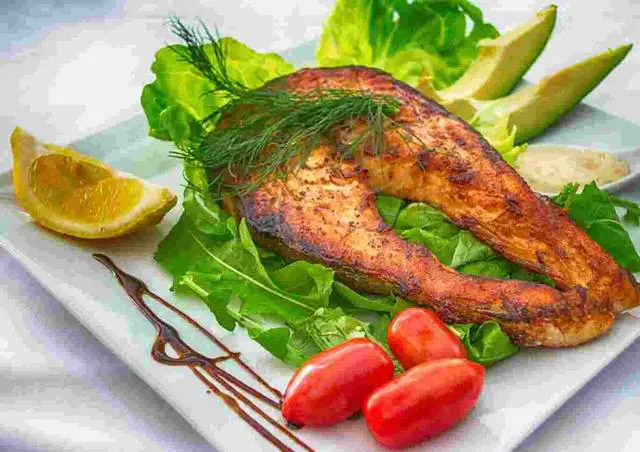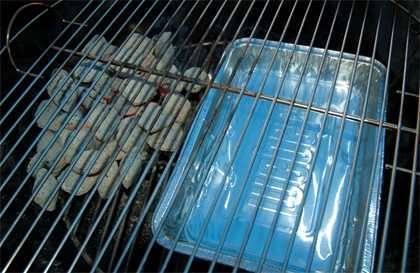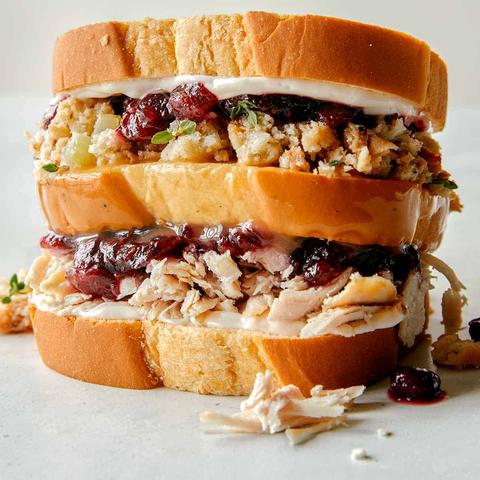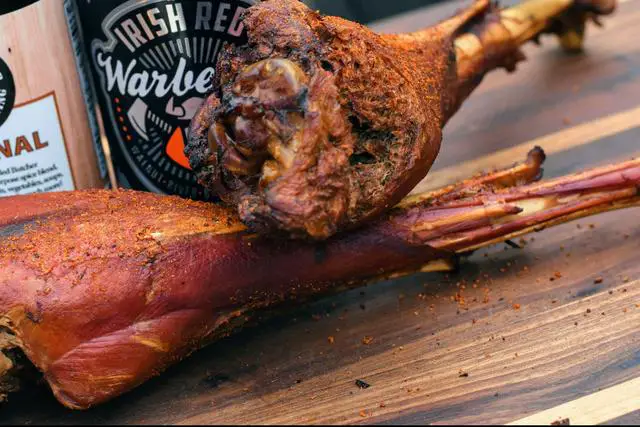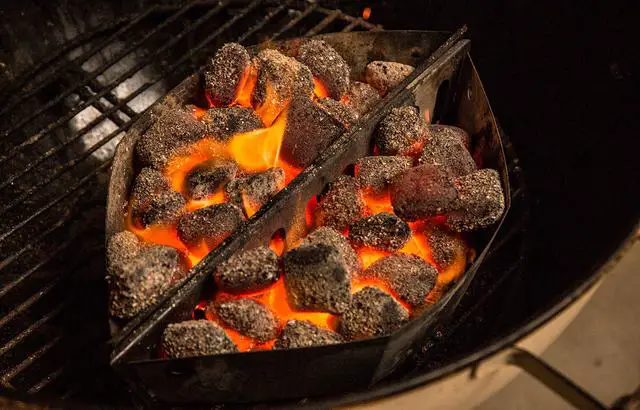
“Master the art of succulent pulled pork with our Weber Kettle – The ultimate cooking method for tender, smoky and flavorful results. Discover the secrets to perfecting this classic barbecue staple and elevate your grilling game to new heights. Unleash your inner pitmaster with our expert tips and techniques, and savor every delicious bite of melt-in-your-mouth pulled pork cooked to perfection on a Weber Kettle.”
Pulled Pork (Pork Butt/Shoulder) on the Weber Kettle: Recipe and How-to Guide
In my opinion, pork butt and/or pulled pork should be the first cut of meat that anyone remotely interested in barbecue should smoke. Mainly because it’s incredibly hard to mess it up; It’s also cheap and tastes wonderful. Two factors that are hard to come by in barbecue.
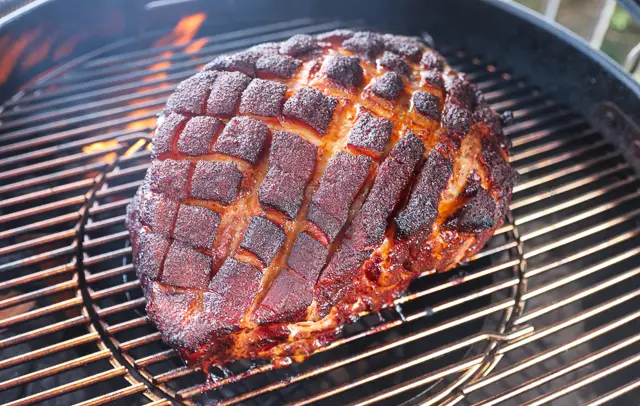
Pulled pork is also something I love experimenting with and this article/recipe is no different. Meaning, if you have a new rub you want to test, pork butt works super well; I also include my personal Pork dry rub below too.
Note: This article is long and covers everything you might want to know about making pulled pork; It’s all encompassing and for all experience levels.
This is one of the reasons pork butt is great, there really isn’t a lot of factors to consider other than weight. Pork butt is a piece of meat that naturally has tons of intramuscular fat. It’s also more or less a homogeneous oval where-in several muscles collide (around 12). In all instances, a bone-in pork butt will weigh more than a boneless pork butt. Usually a bone-in pork butt will weigh around 6-10 lbs. Where-as a boneless pork butt is typically half this amount, at around 3-5 lbs.
What to Look For in Pork Butt
Pork butt is a versatile and flavorful cut of meat that is perfect for smoking and making pulled pork. When choosing a pork butt, there are a few things to consider:
- Weight: Pork butt comes in various sizes, with bone-in cuts weighing around 6-10 lbs and boneless cuts weighing around 3-5 lbs. Choose the size that suits your needs.
- Intramuscular fat: Pork butt naturally has lots of intramuscular fat, which adds flavor and tenderness to the meat. Look for marbling throughout the cut.
- “Money muscle”: The “money muscle” refers to a specific muscle in the pork butt that is highly prized for its tenderness and flavor. While not necessary for pulled pork, it can be reserved for special occasions or to impress guests.
- Dry rub: Consider the flavors you want to infuse into your pulled pork when choosing a dry rub. Sweet ingredients like sugars work well with pork, as do savory spices like paprika, black pepper, and salt.
- Trimming: While not essential, you can trim off any excess fat or remove the false fat cap on the pork butt to enhance the bark (crust) and reduce un-rendered fat.
- Preparation: Seasoning your pork butt overnight allows the flavors to penetrate the meat. Use a generous amount of dry rub and refrigerate it covered until ready to smoke.
What About the Money Muscle?
The “money muscle” refers to a specific muscle in the pork butt that is highly prized in competition barbecue. It is considered to be the best part of the pig and is often showcased as medallions rather than being pulled apart like the rest of the meat. While it can be a great addition to your pulled pork if you want to impress guests or enjoy it yourself as a “Pitmaster tax,” it’s not necessary for the overall flavor and tenderness of the dish. In grocery stores, you can look for a larger money muscle if you prefer, but ultimately, all the muscles in the pork butt come together in the final product when pulled.
Pulled Pork Dry Rub
When it comes to creating a flavorful dry rub for pulled pork, there are endless possibilities. However, a good base for a sweet and savory rub includes ingredients like sugars, paprika, black pepper, and kosher salt.
For sweetness, you can experiment with different sugars such as turbinado sugar, white sugar, brown sugar, or even molasses granules. Combining white and brown sugar in the rub can provide both improved bark texture and flavor.
Paprika is an essential ingredient in most commercial barbecue rubs but using a high-quality paprika like Burlap and Barrel can add more depth of flavor to your rub.
Instead of using freshly cracked peppercorns or coarse black pepper, table-ground black pepper with a mesh size ranging from 18-28 works best for pulled pork.
Kosher salt should be applied separately before the dry rub to ensure even distribution. The amount of kosher salt used will vary depending on the size and shape of the pork butt.
If you want to add some heat to your rub, you can include spicy ingredients like cayenne pepper, chili powder, or red pepper flakes according to your taste preferences.

Prepping the Pork Butt
Pork butt is a versatile and forgiving cut of meat that is perfect for smoking. It is relatively inexpensive and packed with flavor, making it a great choice for both beginners and experienced barbecuers. When selecting a pork butt, you have the option of bone-in or boneless. The bone-in variety can help beginners determine when the meat is done by easily pulling away from the meat when it’s tender. However, the boneless variety is just as delicious and convenient, especially if you’re smoking for a smaller group.
Before smoking the pork butt, you can experiment with different dry rubs to enhance its flavor. A mixture of sugars, such as turbinado sugar, white sugar, and brown sugar, adds sweetness to the bark. Kosher salt should be applied separately to ensure even distribution. Other spices like paprika and black pepper can also be added according to your preference.
When it comes to trimming the pork butt, there isn’t much that needs to be done. You can choose to remove the false fat cap if desired to eliminate un-rendered fat and create more edible bark. Seasoning the pork butt the night before allows for better absorption of flavors and saves time in the morning when you’re ready to smoke.
Seasoning the Pork Butt the Day Before
In my opinion, pork butt is one of the best cuts of meat to experiment with because it’s cheap and versatile. For this recipe, I used a boneless pork butt from Wild Fork Foods – it weighed 4.12 lbs. When seasoning the pork butt, I like to introduce a sweet ingredient like a mixture of sugars such as turbinado sugar, white sugar, or brown sugar. I also add a savory element with kosher salt and table-ground black pepper. Additionally, I use paprika for flavor, preferably one that contributes to the overall taste like Burlap and Barrel paprika.
To season the pork butt, I generously apply the dry rub all over the meat using a large mixing bowl to catch any excess rub. Afterward, I loosely cover it with butcher paper or plastic wrap and refrigerate it overnight on the bottom shelf of my refrigerator. This allows the flavors to penetrate the meat and develop a flavorful bark.
By seasoning the pork butt the day before smoking it, you can save time in the morning and ensure that your rub has enough time to infuse into the meat. The bark is an important part of pulled pork, so taking this extra step can enhance its flavor and tenderness when smoked on a Weber Kettle grill.
Getting the Weber Kettle Ready to Smoke
To prepare the Weber Kettle for smoking, you have several options. One method is to set up a charcoal setup inside the grill. This involves arranging charcoal briquettes in a two-zone setup, with one side of the grill having more coals for direct heat and the other side having fewer coals for indirect heat. You can find more detailed instructions on different charcoal setups in another article.
When it comes to temperature, it’s best to aim for a range of 225-250F. This lower and slower cooking method is ideal for pork butt because many rubs used for this cut contain sugar, which can burn and create a bitter taste if cooked at higher temperatures. If you’re new to using a Weber Kettle, be mindful that it may have temperature spikes, so monitoring and adjusting the heat is crucial for maintaining the quality of your pork butt’s bark.
Adding a water pan can help regulate the temperature and act as a heat sink. It also makes it easier to bring the smoker back to 225-250F when you remove the lid. If your Weber Kettle has its own dedicated water pan (such as with the Slow N’ Sear), fill it up before starting the smoking process.
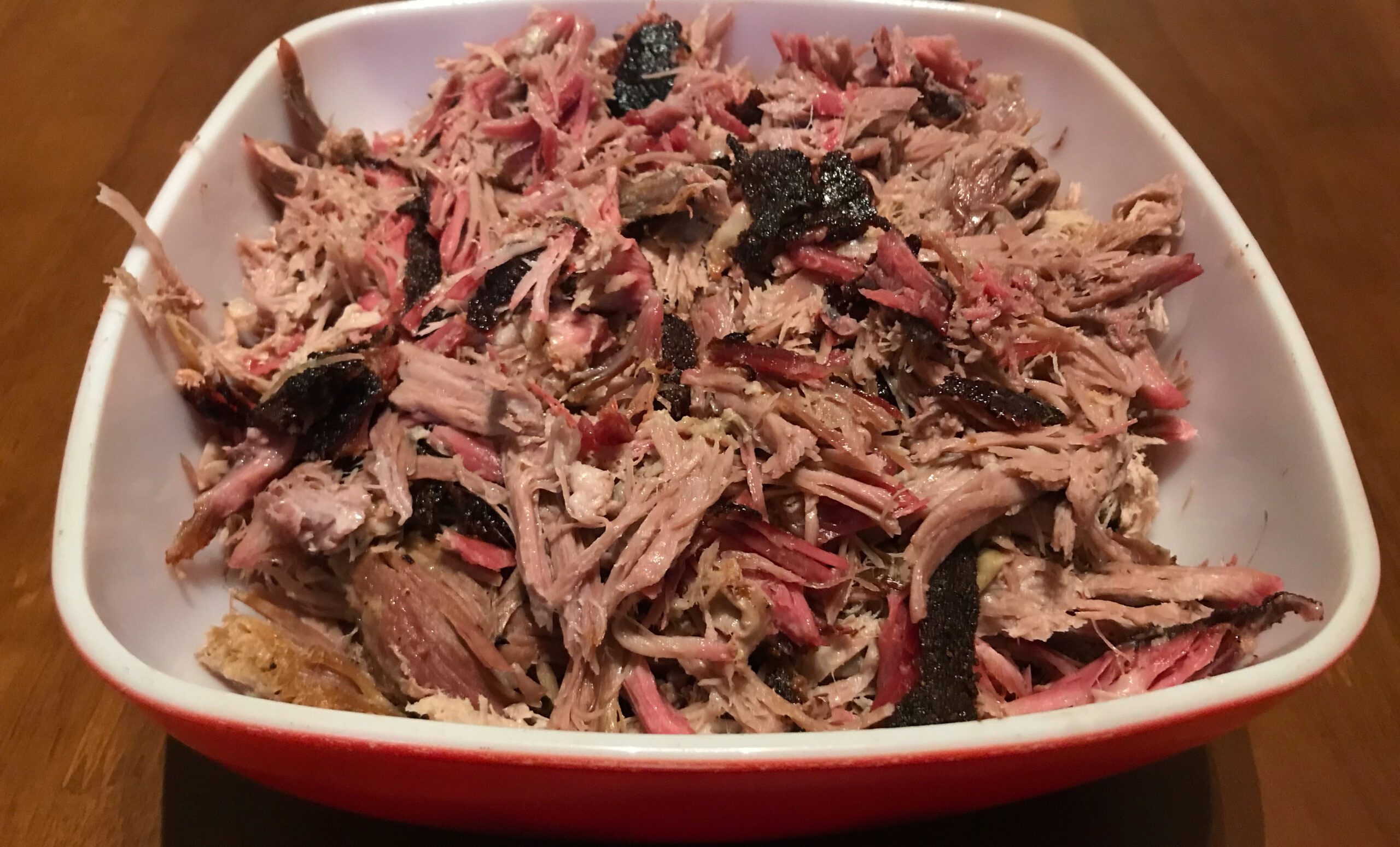
Putting the Pork Butt on the Weber Kettle
Once the Weber Kettle reaches a temperature of 225F, it’s time to put the pork butt on. Place the meat in the cooler zone of the grill, away from direct heat. Add a chunk of hardwood, such as peach wood, for added flavor. If using a bone-in pork butt, avoid placing the probe thermometer near the scapula or blade bone.
I also recommend using a probe thermometer to monitor the internal temperature of the meat. Insert it into the thickest part of the pork butt, making sure to avoid contact with any bones. This will help you gauge when it is done cooking.
Checking on the Pork Butt
During the smoking process, it’s important to periodically check on the pork butt to ensure it is cooking properly and to make any necessary adjustments. Here are a few things to keep in mind:
1. Temperature: Monitor the temperature of your smoker to ensure it stays within the desired range of 225-250F. Adjust the vents or add more charcoal as needed to maintain a consistent temperature.
2. Wood chunks: Every hour or so, add another chunk of hardwood to create smoke and enhance the flavor of the pork butt. Peach wood is recommended for its sweet and mild flavor.
3. Water pan: If using a water pan, check on it periodically to make sure there is still water present. Refill if necessary to maintain proper moisture levels in the smoker.
4. Internal temperature: Around the 4-hour mark, start checking the internal temperature of the pork butt with a probe thermometer. The target temperature for pulled pork is around 195-205F. When inserting the thermometer, avoid hitting any bones as they can give false readings.
5. Spritzing: Some pitmasters like to spritz their pork butt with a mixture of apple juice and cider vinegar during the cooking process to help keep it moist and add flavor. This is optional but can be done every hour or so.
6. Patience: Pulled pork takes time, usually around 10-12 hours depending on the size of your pork butt. Resist the temptation to rush the process by increasing temperatures or opening the lid too frequently. Slow and steady wins this race!
Wrapping the Pork Butt
After the pork butt has been smoking for several hours and has developed a nice bark, it’s time to wrap it. Wrapping the pork butt helps to retain moisture and speeds up the cooking process. You can use either aluminum foil or butcher paper to wrap the meat.
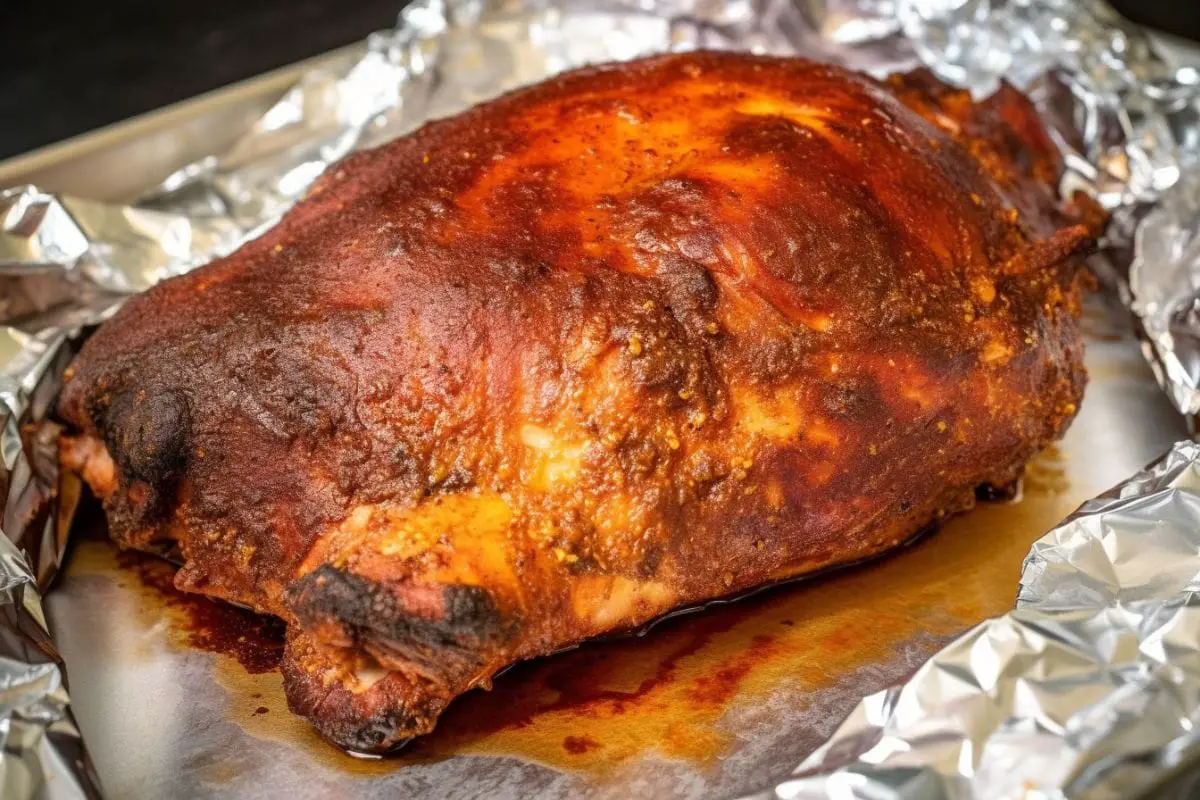
To wrap the pork butt, place it in the center of a large sheet of aluminum foil or butcher paper. Fold up the sides of the foil or paper and tightly seal it around the meat, creating a pouch. Make sure there are no leaks or openings in the wrapping.
Once wrapped, return the pork butt to the smoker and continue cooking until it reaches an internal temperature of around 200-205°F. This can take several more hours, so be patient. The wrapped meat will become incredibly tender and juicy.
Putting the Wrapped Pork Butt Back on the Smoker
After about 4-6 hours of smoking, it’s time to wrap the pork butt. This is known as the “Texas Crutch” method and helps to speed up the cooking process and keep the meat moist. To do this, lay out a large sheet of aluminum foil and place the pork butt in the center. Wrap it tightly, making sure there are no holes or openings for the steam to escape.
Once wrapped, carefully place the pork butt back on the smoker. You can continue to cook it at 225-250F until it reaches an internal temperature of around 200-205F. This can take anywhere from another 4-6 hours, depending on the size of your pork butt.
During this stage, you can also add any additional flavors or ingredients you like. Some people like to pour a bit of apple juice or beer into the foil packet to add moisture and flavor to the meat. Others may brush on a barbecue sauce or glaze for a sticky finish.
Once your wrapped pork butt reaches its target temperature, remove it from the smoker and let it rest for at least 30 minutes before unwrapping and pulling apart with forks or your hands.
Enjoy your delicious pulled pork on sandwiches, tacos, or just by itself!
Pork Butt and Stalling
When smoking a pork butt, you may encounter a phenomenon called “the stall.” The stall refers to a period during the cooking process where the internal temperature of the meat plateaus or even decreases slightly. This can be frustrating for beginners, as it seems like the meat is not progressing.
The stall typically occurs when the pork butt reaches around 160-170°F. During this time, the moisture in the meat evaporates, causing a cooling effect that counteracts the heat from the smoker. This can last anywhere from 1-4 hours, or even longer for larger cuts of meat.
Some pitmasters choose to power through the stall by increasing the heat or wrapping the meat in foil to accelerate cooking. However, many believe that patience is key during this phase. The collagen in the meat begins to break down during the stall, resulting in tender and juicy pulled pork.
To navigate through the stall, simply maintain a consistent temperature on your smoker and let nature take its course. It’s important to use a reliable thermometer to monitor the internal temperature of the pork butt throughout the entire cooking process.
Once the internal temperature reaches around 195-205°F, it’s time to remove the pork butt from the smoker. The meat should be tender and easily shred apart with a fork. Allow it to rest for about 30 minutes before pulling it apart and serving.
Remember, smoking a pork butt is a slow and steady process that requires patience. Embrace the stall as part of your barbecue journey and enjoy every step along the way.
When is Pulled Pork “Done”
Pulled pork is considered “done” when it reaches an internal temperature of 195-205°F (90-96°C). This is the range at which the collagen in the meat breaks down and becomes tender, allowing for easy shredding. However, it’s important to note that cooking times can vary depending on factors such as the size of the pork butt and the temperature of your smoker or grill.

Using a reliable meat thermometer is crucial to ensure that your pulled pork is cooked to perfection. Insert the thermometer into the thickest part of the meat, avoiding contact with any bones. Once it reaches the target temperature range, you can be confident that your pulled pork is ready to be removed from the smoker or grill.
Pulling the Pork
Once the pork butt reaches an internal temperature of around 195-203F, it’s time to take it off the smoker. The meat should be tender and easily pull apart with a fork or tongs. Place the pork butt on a large cutting board or tray, and let it rest for about 30 minutes to allow the juices to redistribute.
After resting, it’s time to start pulling the pork. Using two forks or your hands (with gloves), shred the meat into bite-sized pieces. Remove any large chunks of fat or connective tissue as you go. Some people like to mix in some additional barbecue sauce at this stage, but it’s not necessary as the meat should already be flavorful and moist.
Once all the pork is pulled, you can serve it immediately or keep it warm in a covered dish until ready to eat. Pulled pork is incredibly versatile and can be used in sandwiches, tacos, salads, or served on its own with some barbecue sauce on the side. Enjoy!
Using a Finishing Sauce?
Using a finishing sauce is a personal preference when it comes to pulled pork. Some people like to serve the meat as is, while others prefer to add a sauce for added flavor and moisture. If you choose to use a finishing sauce, there are many options available. You can go for a traditional barbecue sauce, or try something different like a vinegar-based sauce or even a fruity glaze.
To make a simple barbecue finishing sauce, you can combine ketchup, brown sugar, apple cider vinegar, Worcestershire sauce, and various spices like garlic powder, onion powder, and paprika. This will give your pulled pork a tangy and sweet flavor that pairs well with the smokiness of the meat.
If you prefer a vinegar-based finishing sauce, you can mix apple cider vinegar, brown sugar or honey, red pepper flakes for heat, salt, and pepper. This will give your pulled pork a tangy and slightly spicy kick that is popular in some regions.
What Buns to Use for Pulled Pork?
When it comes to choosing the perfect buns for pulled pork, there are a few options that work well. The most popular choice is the classic hamburger bun. It’s soft, sturdy, and can hold up to the juicy pulled pork without falling apart. Another option is a brioche bun, which adds a touch of sweetness and richness to the sandwich. If you prefer something with a bit more texture, try using a pretzel bun or even a ciabatta roll. These bread options provide a bit more crunch and flavor to complement the tender pulled pork.
Ultimately, the choice of bun comes down to personal preference. Some people like a plain and simple bun that lets the flavors of the pulled pork shine through, while others enjoy a bun with added flavor and texture. Whichever option you choose, make sure it’s sturdy enough to hold all of the delicious pulled pork and any additional toppings or sauces you may want to add.
Other Toppings?
When it comes to pulled pork, there are countless toppings and sauces that you can serve alongside it. Some popular options include coleslaw, barbecue sauce, pickles, and hot sauce. These toppings add different flavors and textures to the pulled pork, allowing you to customize it to your liking.
Coleslaw is a classic topping for pulled pork sandwiches. Its crispness and tanginess provide a refreshing contrast to the rich and tender meat. You can either choose to mix the coleslaw directly into the pulled pork or serve it on top of the sandwich.
Barbecue sauce is another staple when it comes to pulled pork. There are many different types of barbecue sauces available, ranging from sweet and tangy to spicy and smoky. You can either brush the sauce onto the meat while it’s cooking or serve it on the side for dipping or drizzling.
Pickles add a burst of acidity and crunch to pulled pork sandwiches. Whether you prefer dill pickles, bread-and-butter pickles, or even pickled jalapenos, they all work well with the rich flavors of the meat.
If you like some heat, hot sauce is a great addition to pulled pork. Whether you choose a traditional Louisiana-style hot sauce or opt for something more exotic like sriracha or chipotle hot sauce, it adds a spicy kick that complements the savory flavors of the meat.
Final Thoughts
Pork butt, also known as pork shoulder, is a versatile and forgiving cut of meat that is perfect for smoking and making pulled pork. It is affordable, flavorful, and easy to work with, making it an ideal choice for both beginners and experienced barbecue enthusiasts. Whether you choose bone-in or boneless pork butt, the end result will be delicious and tender pulled pork.
When preparing your pork butt, you have the option to trim off the false fat cap for a more desirable bark and eliminate any un-rendered fat. However, this step is not necessary if you prefer to leave the fat cap intact.
Experimenting with different dry rubs and flavors is part of the fun when smoking pulled pork. You can use a variety of ingredients such as sugars, spices, and herbs to create your own unique rub. Seasoning the meat the night before allows the flavors to penetrate and develop overnight.
Smoking on a Weber Kettle grill is a popular method for cooking pulled pork. Maintaining a temperature of around 225-250F ensures that the sugar in the rub does not burn and result in a bitter taste. Using a water pan can help regulate temperature and keep the smoker lower in temperature for longer periods of time.
Overall, pulled pork made from pork butt is a crowd-pleasing dish that is perfect for gatherings or competitions. With its juicy tenderness and endless flavor possibilities, it’s no wonder why so many people consider it their go-to barbecue staple.

Pulled Pork on the Weber Kettle
Pulled pork is a versatile and delicious dish that is perfect for barbecue lovers of all experience levels. It is incredibly hard to mess up, affordable, and packed with flavor. One of the best cuts of meat to use for pulled pork is the pork butt or shoulder, which is naturally tender and fatty.
When selecting a pork butt, you have the option of bone-in or boneless. While some recommend using bone-in for beginners because it helps determine when the meat is done, boneless pork butt works just as well. The size of the pork butt can vary, but it’s worth noting that even a smaller 3-5 lb cut can yield a lot of pulled pork for a family.
The “money muscle” is a highly sought-after part of the pork butt in competition barbecue. This muscle, also known as the pectoralis profundi, is heavily marbled with intramuscular fat, resulting in both tenderness and succulence. It’s great to reserve this portion for yourself or impress guests who appreciate barbecue.
When it comes to seasoning your pulled pork, there are endless possibilities. Experimenting with different dry rubs and ingredients can add unique flavors to your dish. A combination of sugars like turbinado sugar, white sugar, and brown sugar works well for sweetness. Kosher salt should be applied separately to ensure even distribution.
Trimming your pork butt is optional but can enhance the final result. Removing the false fat cap allows for more edible bark and reduces un-rendered fat chunks in the pulled meat. Seasoning your pork butt ahead of time allows for better flavor penetration and convenience when starting early in the morning.
Smoking your pulled pork on a Weber Kettle grill requires setting up proper charcoal placement and maintaining a temperature of around 225-250°F. Using a water pan as a heat sink and adding wood chunks for smoky flavor can enhance the cooking process. Probing the thickest part of the pork butt with a thermometer ensures accurate cooking times.
Overall, pulled pork on the Weber Kettle is a delicious and rewarding barbecue experience. Whether you’re a beginner or an experienced pitmaster, pork butt is a fantastic cut to experiment with and enjoy.
Equipment
For this recipe, you will need the following equipment:
- Weber Kettle grill
- Charcoal briquettes or lump charcoal
- Wood chunks or chips for smoking (preferably peach wood)
- Probe thermometer (such as the Thermoworks Smoke X4)
- Baking pan
- Aluminum foil
- Cooling racks
- Mixing bowl
- Plastic wrap or butcher paper
- Tongs or meat claws for shredding the pork
Pork butt is a versatile and forgiving cut of meat, making it perfect for beginners. It is typically sold bone-in, but boneless options are available as well. The size of the pork butt can vary, with bone-in cuts weighing around 6-10 lbs and boneless cuts weighing around 3-5 lbs. If using a bone-in pork butt, the bone can be used to determine when the meat is tender and ready to be pulled.
To prepare the pork butt, you can choose to trim off any excess fat or leave it on for added flavor. Removing the false fat cap can result in more edible bark and reduce un-rendered fat. Season the pork butt generously with your choice of dry rub, ensuring even coverage on all sides.
The Weber Kettle grill offers several methods for smoking meats. For this recipe, we recommend setting up a charcoal fire in one side of the grill using either charcoal briquettes or lump charcoal. Aim for a temperature range of 225-250°F to avoid burning the sugar-heavy rub.
To maintain a steady temperature, you can use a water pan as a heat sink. This will also help keep the smoker at a lower temperature, which is ideal for pork butt. Place the seasoned pork butt in the cooler zone of the grill and add a chunk of hardwood, such as peach wood, for smoke flavor.
Monitor the internal temperature of the pork butt using a probe thermometer. Insert it into the thickest part of the meat, avoiding contact with any bones. For bone-in cuts, avoid probing near the scapula or blade bone.
Continue cooking the pork butt until it reaches an internal temperature of around 195-205°F. At this point, the meat should be tender and easily pulled apart. Remove the pork butt from the grill and let it rest for about 30 minutes.
Using tongs or meat claws, shred the pork butt into bite-sized pieces. Discard any excess fat or undesired portions. The pulled pork can be served as-is or mixed with your favorite barbecue sauce for added flavor.
Ingredients
– Pork butt/shoulder (6-10 lbs for bone-in, 3-5 lbs for boneless)
– Dry rub of your choice (suggested sweet and savory rub with sugars, paprika, black pepper, kosher salt)
– Wood chunks or chips for smoking (peach wood recommended)
– Optional: water pan for heat control and moisture
My Pork Dry Rub
When it comes to seasoning pork, I like to use a combination of sweet and savory flavors. My go-to dry rub for pork includes a mixture of sugars, such as turbinado sugar, white sugar, and brown sugar. The white sugar helps create a nice bark on the meat, while the dark brown sugar adds flavor.
In addition to the sugars, I also add paprika for a touch of smokiness and depth of flavor. I prefer using a high-quality paprika that actually contributes to the taste rather than just adding color. Table-ground black pepper is my choice for this rub, as freshly cracked peppercorns or larger mesh black pepper can be too overpowering for pulled pork.
I always start with kosher salt as the base seasoning to ensure even distribution. The amount of salt used will vary depending on the size and shape of the pork butt. After applying the salt, I add other ingredients like spices or herbs to customize the rub to my liking. If I want some heat, I’ll include cayenne pepper or red pepper flakes.
Instructions
1. Start by preparing the pork butt. If using a bone-in pork butt, remove the false fat cap for more edible bark. Trim any excess fat or connective tissue if desired.
2. Season the pork butt generously with your choice of dry rub. Make sure to cover all sides of the meat.
3. Wrap the seasoned pork butt in plastic wrap or butcher paper and refrigerate overnight to allow the flavors to penetrate into the meat.
4. Prepare your Weber Kettle for smoking by setting up a charcoal fire on one side of the grill. Aim for a temperature range of 225-250F.
5. Place a water pan in the grill to act as a heat sink and maintain a lower temperature. This is especially helpful for smoking pork butt.
6. Once the grill has reached the desired temperature, carefully place the seasoned pork butt on the cool side of the grill away from direct heat.
7. Add a chunk of hardwood, such as peach wood, to create smoke flavors while cooking.
8. Monitor the internal temperature of the pork butt using a probe thermometer inserted into the thickest part of the meat, avoiding any bones if present.
9. Continue smoking at a steady temperature until the internal temperature reaches around 195-205F, which indicates that the meat is tender and fully cooked.
10. Remove the smoked pork butt from the grill and let it rest for about 30 minutes before pulling it apart using two forks or shredding claws.
11. Serve pulled pork on buns with your favorite barbecue sauce or enjoy it as is with some coleslaw and pickles on the side.
Note: Cooking times may vary depending on the size and thickness of the pork butt. It is recommended to use a thermometer for accurate doneness.
Seasoning Pork Butt
Pork butt is a versatile cut of meat that can be seasoned in various ways to enhance its flavor. One popular method is to use a dry rub, which consists of a combination of spices and herbs. You can experiment with different rubs or use your favorite recipe to create a unique flavor profile for your pulled pork.
When seasoning pork butt, it is important to thoroughly coat the meat with the dry rub. This can be done by generously sprinkling the rub all over the surface of the meat and gently patting it down to ensure it adheres well. The dry rub will not only add flavor but also help form a delicious crust or bark on the outside of the pork butt during smoking.
You can customize your dry rub by adjusting the proportions of different ingredients according to your taste preferences. Some common ingredients used in pork butt dry rubs include sugar, salt, paprika, black pepper, garlic powder, onion powder, and cayenne pepper. Feel free to get creative and add other spices or herbs that you enjoy.
Smoking the Pork Butt
Once the Weber Kettle has reached a temperature of 225-250°F, it’s time to start smoking the pork butt. Place the meat in the cool zone of the grill, away from direct heat. Add a chunk of hardwood, such as peach, for added flavor.
Using a probe thermometer, insert it into the thickest part of the meat, avoiding the bone if using a bone-in pork butt. This will allow you to monitor the internal temperature throughout the smoking process.
Keep an eye on the temperature and adjust airflow as needed to maintain a consistent temperature inside the grill. The goal is to cook the pork butt low and slow until it reaches an internal temperature of around 195-205°F.
During this time, resist the temptation to open the lid too often as it will cause heat loss and extend cooking time. The pork butt will take several hours to smoke depending on its size, so be patient and let it slowly cook until tender.
Continue to monitor the internal temperature until it reaches your desired level of tenderness. Once done, carefully remove the pork butt from the grill and let it rest for at least 30 minutes before pulling or slicing.
Remember that smoking times can vary based on factors like weather conditions and grill setup, so use your probe thermometer as your guide to determine when your pulled pork is perfectly cooked.
Wrapping the Pork Butt
After the pork butt has been smoking for a few hours and has developed a good amount of bark, it’s time to wrap it. This step is optional, but it can help speed up the cooking process and keep the meat moist. You can use either aluminum foil or butcher paper to wrap the pork butt.
To wrap the pork butt, place it in the center of a large sheet of foil or butcher paper. Fold up the sides and tightly seal the edges to create a tight packet. Make sure there are no openings for steam to escape.
Wrapping the pork butt helps to retain moisture and tenderize the meat. It also helps to speed up the cooking process by trapping heat and creating a mini-oven effect. Some pitmasters prefer foil for its ability to hold in more moisture, while others prefer butcher paper for its ability to allow some moisture to escape, resulting in a crisper bark.
Waiting for Tenderness
Once the pork butt is on the smoker, it’s time to wait for tenderness. This can take anywhere from 6-12+ hours depending on the size of the cut and the temperature of your smoker. It’s important to maintain a steady temperature throughout the cooking process, so keep an eye on your thermometer and adjust as needed.
During this time, you can sit back and relax or continue to monitor your smoker. Some people like to spritz their pork butt with apple juice or other liquid every hour or so to keep it moist, but this is optional. Just make sure not to open the lid too frequently, as this will cause heat loss and extend your cooking time.
Resting
After the pork butt has reached its desired temperature, it is important to let it rest before pulling. Resting allows the juices in the meat to redistribute and ensures a more tender and flavorful final product. To rest the pork butt, remove it from the smoker and loosely tent it with aluminum foil. Let it rest for at least 30 minutes, but up to an hour is even better. This resting period will result in juicier pulled pork.
During the resting period, you can prepare any additional sauces or sides you plan on serving with the pulled pork. It also gives you time to clean up your cooking area and get everything ready for serving. Once the resting time is up, carefully unwrap the pork butt and transfer it to a cutting board or large platter.
Using two forks or meat claws, begin pulling apart the meat into small shreds. Remove any excess fat or gristle as you go along. The pulled pork should be juicy, tender, and easy to shred apart. At this point, you can mix in some of your favorite barbecue sauce if desired.
Serve the pulled pork on toasted buns with coleslaw, pickles, or any other toppings of your choice. Pulled pork is incredibly versatile and can be used in various dishes such as tacos, sandwiches, nachos, or even pizza toppings. Enjoy!
Pulling the Pork
Once the pork butt reaches an internal temperature of around 195-205F, it’s time to take it off the smoker. This temperature range ensures that the collagen in the meat has broken down, resulting in tender and juicy pulled pork.
Carefully remove the pork butt from the smoker and place it on a cutting board or large tray. Allow it to rest for about 30 minutes to an hour. This resting period allows the juices to redistribute within the meat, making it even more flavorful.
To pull the pork, use two forks or your hands (with gloves) to shred the meat apart. The cooked pork should easily fall apart into tender strands. Discard any excess fat or connective tissue as you go along.
Once all the pork is shredded, you can serve it as is or mix in your favorite barbecue sauce for added flavor. Pulled pork is incredibly versatile and can be used in sandwiches, tacos, sliders, or even as a topping for nachos.
Enjoy your delicious homemade pulled pork and savor the fruits of your smoking labor!
In conclusion, using a Weber kettle to cook pulled pork results in delicious and tender meat. The unique design of the kettle allows for even heat distribution and excellent smoke flavor. Whether you’re a BBQ enthusiast or just looking for a crowd-pleasing meal, pulled pork cooked on a Weber kettle is sure to impress.
Learn More About Grilling
If you want to learn more about grilling, check out these other helpful resources!


